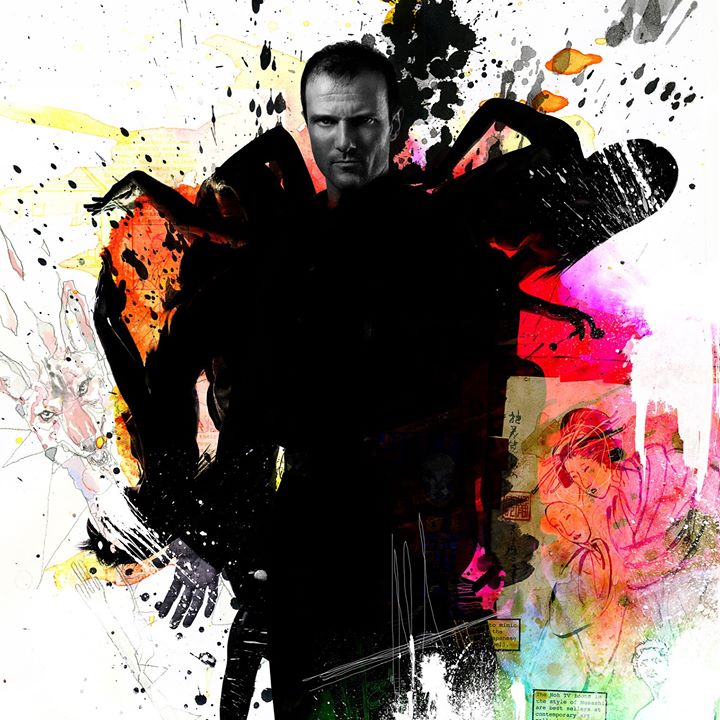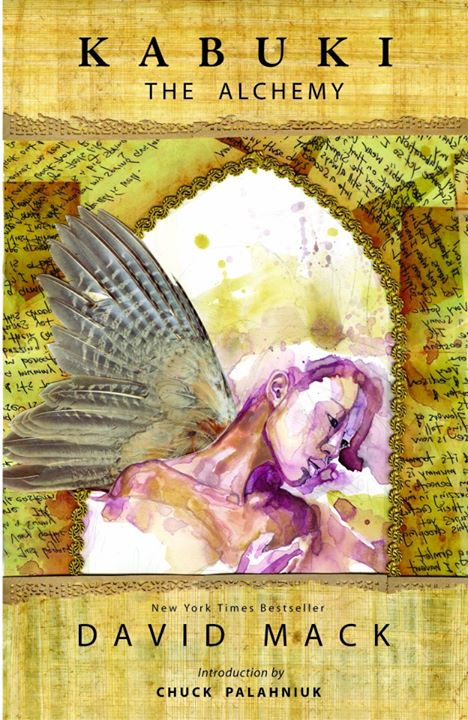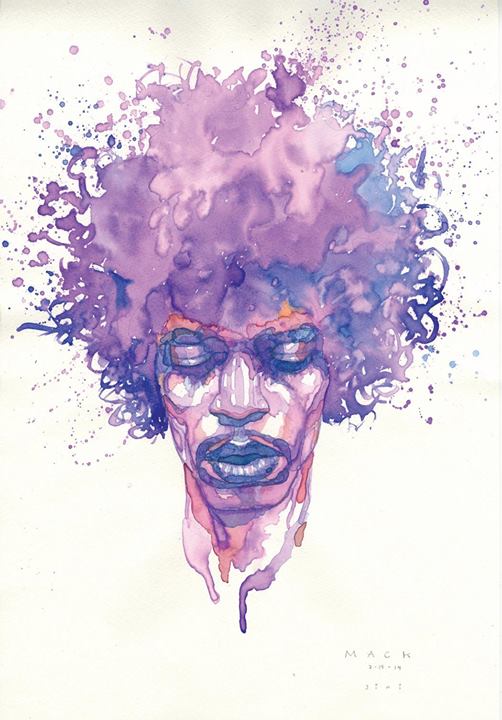“Comics are the rock and roll of literature.”

I have been reading comic books for well over half of my life and among those I return to again and again, is David Mack’s Kabuki. At its heart it is a story of personal growth and exploration. On the surface it is a marriage of art and words that must be seen and read to be felt. David Mack’s multi-media style is instantly recognizable after one viewing. His art has been embraced beyond the world of comic books. It has hung in the Los Angeles Museum of Art, as well as in galleries alongside the work of Gustav Klimt and Egon Schiele.
Musicians including Paul McCartney, Tori Amos, Amanda Palmer and Dead Can Dance have collaborated with David in the form of album covers, multi media pieces, and video directing. Top gaming companies and John Woo have turned to him for creative guidance in video games, and he has even contributed the artwork for Dr. Arun Ghandi’s essay on the “Culture of Non-Violence.”
As if that were not enough, he has also authored the critically acclaimed children’s book The Shy Creatures. His work speaks to the beauty of life and the journey of the self. It speaks to those wishing to be understood, and the shy creature in all of us. Thankfully, David was not shy in offering us some in-depth insight into his eclectic creative landscape.
He recently took time out of his busy schedule on the way to the Wizard World Portland Comic Con to answer some questions for Cultural Weekly. Interview below.
[alert type=alert-white ]Please consider making a tax-deductible donation now so we can keep publishing strong creative voices.[/alert]

John Kost: Where do comic books and graphic novels fit within the larger conversation on the cultural institutions of Literature and Art?
David Mack: In some ways comics are the rock and roll of literature. In that they are a hybrid medium, that works when it is absorbing from outside itself. The real magic of comic books is that the movement, and the art of them, happens not on the page, but in the reader’s mind between the panels. You design the panels in just the right way and with the right composition and rhythm and pace so that the reader fills in the movement between them in their own mind. Inside the mind of the reader is where my real storytelling canvas lives.
JK: When did you first start to use a multi-media style in your artwork and who are your influences?
DM: I’ve made things since I was a child. My mother was a first grade teacher and she always had art supplies around. I’d see her constructing things to use as lesson plans for her students to learn visually. I suppose that early example of constructing images as communication was absorbed in my formative years. I began making things three dimensionally first, with clay, and then wooden blocks that I would eventually nail together, and then constructing out of cardboard and empty boxes: vehicles, planes, castles and robots. I started drawing on the things that I built and then I began drawing to make stories. Ultimately, my writing, my visuals, my stories in my comics, are a laboratory for me to work things out, to experiment, and tinker and play and make a kind of sense and order of things in my life, my ideas, my experiences, from childhood onward.

JK: How much research goes into the art and writing the characters you created, Echo and Kabuki?
DM: My Cherokee uncle inspired much of Echo’s story. He would tell me Native stories when I was very little, and he would ask me to draw the stories and icons from the stories. It was a subject I was immersed in as a child, and I continued to be a part of it when I was older. The storyteller as guide, and the artist as shaman are subjects that I appreciated from my uncle’s stories. Some of the insight into Deaf Culture comes from biographies and autobiographies I have read of children who grew up deaf and I was fascinated by their unique view of the world. I was making Kabuki in college. I was learning Japanese history and mythology and various philosophies and world religions, as well as travelling to Japan, so I had this rich world of mythology and information that was pouring into my own. I did not want to fall into the trap of making the main character an idealized version of myself. So I thought that I could write more unselfconsciously about very personal things in my life if I could write through a mask in a way. I thought that I could tell a personal story but make many of the details very different from myself. I began with the choice to make the main character a different gender, and then to set it in a different part of the world, with a different culture, and even in the ambiguous near future.
JK: How have you and Kabuki both changed since its first inception?
DM: The first volume was created and published as my college senior writing thesis in literature. I was twenty when I began the first volume in 1993, and I just kept making it afterwards. Over time, each volume of Kabuki does seem to represent a different arc of growth in my life and work, just as it does with the main character. The book was really a laboratory for me to integrate my passions and interests and make sense of things in my own life that I was experiencing in a very early formative time for me. When I look back on that first volume, I can see so many things now that I was working out unconsciously at the time. I think the book was a vehicle for my conscious efforts and my unconscious mind to collaborate in a way that was probably very helpful and therapeutic for me.
[alert type=alert-white ]READ DAVID MACK’S ESSAY ON THE VALUE OF CULTURE[/alert]
JK: How has the culture of comics and graphic novels transformed since your first published work?
DM: I think perhaps the mainstream has embraced the comic book culture much more now than 20 years ago when I began Kabuki. The medium is a very fertile and wide medium, and I feel like any kind of story can be told in it. I’m reminded of an interview with Andy Warhol from 1973. When he was asked of his influences and inspiration, he said: “Comic books. Comic books make things the way they are today.”

JK: How would you describe your relationship and/or collaborative process with some of the writers and artists you have worked with?
DM: A lot of projects are dear to me because of the collaborations involved. Really, each collaboration is different; like when I began writing Daredevil, with Joe Quesada on art, or the first Daredevil: Wake Up story I did with Brian Michael Bendis, or the poetry collaboration with Neil Gaiman, or Comic Book Tattoo that I did with Tori Amos. I’ve been fortunate to work with many of my favorite artists. On the recent Daredevil: End of Days story that I wrote with Bendis, the artists on it are Bill Sienkiewicz and Klaus Janson, with Alex Maleev also contributing. These are all artists that I respect and Bill and Klaus are artists that I grew up with and have inspired me since I was a child. When writing Kabuki for other artists, it’s always been fun to have a character have a unique visual personality. I began that as an experiment in the third volume and had a different artist draw each character, while I drew Kabuki. I really enjoy writing for other artists because I learn so much from them in how they interpret my writing. Collaboration is such a fuel for creativity. And you never know what the ripple effects of things will be. It was that first Kabuki story that got me the invite to be the writer of Daredevil for Marvel Comics. That invitation came in 1997 from Joe Quesada and Jimmy Palmiotti. I began working as writer on Daredevil in 1998 taking over from writer/director Kevin Smith. After that Joe Quesada had asked me to write and draw a series for Echo, the character created in my first Daredevil story, and that Echo story became another storyline in the Daredevil series as well. I should also mention collaborating with Bill Sienkiewicz on Dexter: Early Cuts. We were already working together on Daredevil: End of Days. But on Dexter, we collaborated so closely. It was really my favorite part of the experience: working with Bill.
JK: Can you describe how The Shy Creatures went from an idea in a larger story to becoming an acclaimed children’s book?
DM: The Shy Creatures was a book that Kabuki recalls reading as a child. It appears in Kabuki: The Alchemy as a kind of double narrative in the story. I tried to give it a simple retro feeling to contrast the mixed media of the surface story. Children’s literature is a theme in Kabuki, and I had done this before in Kabuki: Metamorphosis, in which Kabuki, as a child, recalls reading a book called My Invisible Friend. That happens to be the first children’s book that I made in college for my Children’s Literature class. In the case of The Shy Creatures, my children’s book agent Allen Spiegal showed Kabuki to MacMillan and they wanted to make the story into an actual children’s book, which they did.

JK: What one character in comics, film, or TV, do you wish you could write or create the art for?
DM: It would be fun to write and draw a Batman story. I would love to work on the Fight Club sequel with author Chuck Palaniuk. Tyler Durden would be a joy to work on. Writing the Punisher would be a blast. Doctor Strange. Working on a Sandman story with Neil Gaiman. Now that would be something.
JK: Would you consider a television or big screen adaptation of your work on Kabuki? Or even a Shy Creatures animated short?
DM: Yes. I am currently fielding offers for just that sort of thing. There are a couple studios interested in creating film and TV versions of The Shy Creatures. And I am inclined to see Kabuki as a long-form TV series. You may know that FOX had bought the rights for Kabuki four times for a live action feature film. After I got the rights back from Fox, Lawrence Bender, Quentin Tarantino’s producer, had some great ideas of how to film Kabuki. But now, I think the landscape is right and Kabuki would make a great episodic television series. Each issue is planned like an episode, and each issue of most volumes could be translated directly into an episode. In 2013 I signed with Cat Mihos, Neil Gaiman’s producer and assistant, as producer with her partner Rod Hamilton, and Neil as executive producer.
JK: What advice do you have for the aspiring writer or artist that is trying to do something different, new, and fresh?
DM: Imagine the book that you wish existed but does not exist. And then create that. Make it with all of your passion and effort. Start it. Finish it. And then show it to people. Keep doing that with every different project. The best way to learn how to make a comic, writing or drawing, is to just make it. You learn in the process what you want from it, and what it wants to be from you.

JK: You run into the ghost of M. C. Escher at the bookstore. You have time for one question. What do you ask him?
DM: I ask him to collaborate on a comic book project with me. We’ll do it Marvel Style. I’ll give him the idea, he’ll draw it, and I’ll come back in with the script. By the way, when I die, I’ll plan to die Marvel Style too. And come back issues later with a new costume.
JK: What is next for David Mack?
DM: Brian Bendis and I are making a creator-owned project. That is very exciting. And just tonight, at Brian’s house where I am now typing this from, Brian and I had a conference call with Bill Sienkiewicz about all three of us working on a different creator-owned project. I’ve written several new children’s books that I will make the art to. I have a new art book in the works. I have some gallery exhibits planned, another show with works of Egon Schiele and Gustav Klimt, and I have work in an opening February 22 in Los Angeles at Gallery Nucleus, Like a Rolling Stone: Rock & Roll Reflection for which I contributed a painting of Jimi Hendrix and David Bowie. And Kabuki readers will be pleased to hear that I am working on the next stories. 2014 is the 20-year anniversary of Kabuki being published as a comic, so there are some special things in the works for that. Brush up on reading all your Kabuki volumes in the meantime. And some other things I can’t talk about right now. But there is another project at Marvel that I am writing with Brian as well.
For a look at David’s creative process, view this brief clip from the documentary The Men Without Fear: Creating Daredevil:
